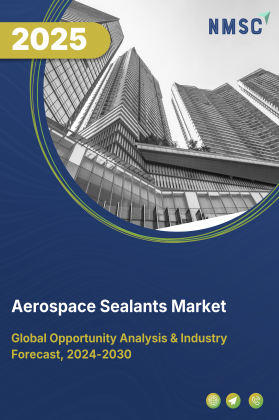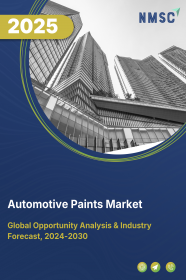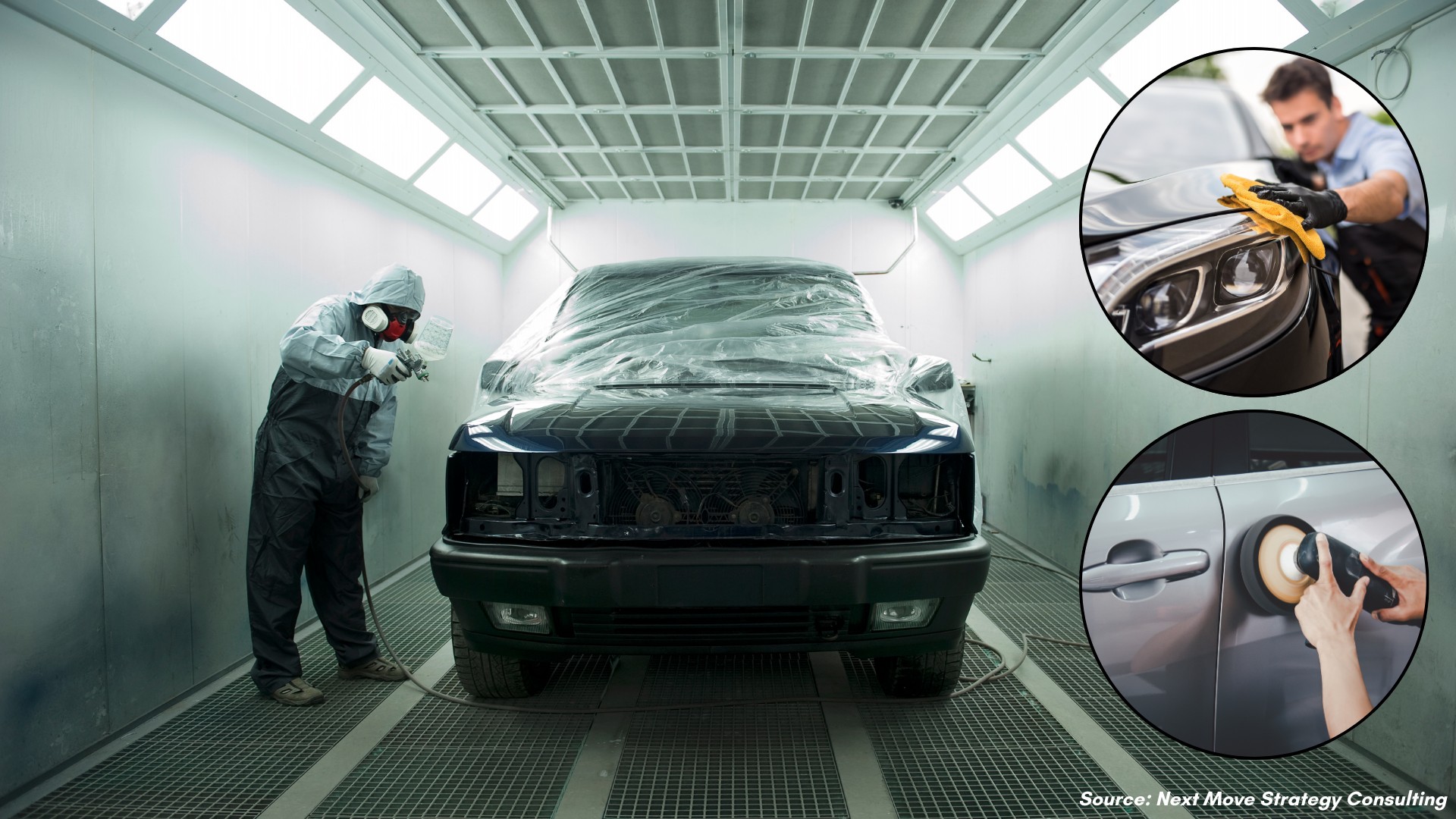
Aerospace Sealants by Resin Type (Polysulfide, Silicone, Polyurethane and Others), by Aircraft Type (Commercial Aircraft, Military Aircraft, General Aviation and Others), by Application (Fuel Tank Sealants, Airframe, Windshields & Canopy Sealants, Avionics & Electrical Sealants, Cabin Interiors & Flooring, and Specialty Applications – Vapor Barrier Sealants, Firewall, Rapid-Cure Repair Kits), and by End User (OEM, MRO and Others) – Global Opportunity Analysis and Industry Forecast, 2025–2030
Industry Outlook
The global Aerospace Sealants Market size was valued at USD 1369.9 million in 2024, with an estimation of USD 1468.5 million in 2025 and is predicted to reach USD 2079 million by 2030 with a CAGR of 7.2% from 2025-2030. The sector is growing steadily, driven by the expansion of commercial aviation, advancements in aircraft design, and rising space exploration activities.
Increasing global air travel is prompting airlines to expand fleets, creating demand for specialized sealants that ensure durability, prevent leaks, and protect lightweight materials like composites and aluminum alloys from corrosion and vibration.
At the same time, modern aircraft designs require innovative sealants capable of withstanding extreme conditions, while space programs depend on high-performance solutions to endure radiation, vacuum environments, and temperature fluctuations, making aerospace sealants indispensable for both aircraft manufacturing and long-term mission reliability.
Expansion of Commercial Aviation Drives the Market Growth
The expansion of commercial aviation is a key driver for the aerospace sealants market growth, as the growing global demand for air travel is prompting airlines to increase fleet sizes and aircraft production. Modern aircraft increasingly use lightweight materials like composites and aluminum alloys, which require specialized sealants to ensure structural integrity, prevent leaks, reduce vibration, and protect against corrosion.
Rapid growth in regions such as Asia-Pacific, the Middle East, and Latin America further boosts demand, making aerospace sealants essential for both new aircraft manufacturing and maintenance of existing fleets.
Advancements in Aircraft Design Fuels Market Expansion
Advancements in aircraft design are driving the aerospace sealants market demand by creating a need for specialized sealing solutions that accommodate modern engineering requirements. Contemporary aircraft increasingly use lightweight materials such as composites and advanced aluminum alloys to improve fuel efficiency, reduce emissions, and enhance overall performance.
These materials require high-performance sealants to maintain structural integrity, prevent leaks, and resist extreme temperatures and pressure variations. As aircraft designs become more sophisticated, the demand for innovative sealants that reliably bond diverse materials and withstand harsh operational conditions continues to grow, fuelling industry expansion.
Increase in Space Exploration Activities Boost Market Demand
The increase in space exploration activities is driving the aerospace sealants market expansion by creating demand for specialized sealants capable of withstanding the extreme conditions of space. Missions involving satellites, space stations, and deep-space exploration require sealants that endure high radiation, extreme temperatures, and vacuum environments while maintaining structural integrity and preventing leaks.
As governments and private companies expand their space programs, the need for reliable, high-performance aerospace sealants grows, making them essential for both spacecraft manufacturing and long-term mission durability.
High Cost of Advanced Sealant Materials and Application Processes Limits the Market Growth
One significant restraint for the market is the high cost of advanced sealant materials and application processes. Aerospace-grade sealants must meet stringent performance standards, including resistance to extreme temperatures, pressure, chemicals, and vibration, which makes their development and production expensive.
Additionally, the application and curing processes require specialized equipment and skilled labor, further increasing operational costs. These high costs limit adoption, especially among smaller aircraft manufacturers or in regions with budget constraints, slowing overall aerospace sealants industry growth.
Growing Demand for MRO Services Creates New Growth Opportunities for the Market
A key opportunity in the aerospace sealants market lies in the growing demand for maintenance, repair, and overhaul services. As the global aircraft fleet continues to age and expand, airlines and aerospace operators increasingly require high-performance sealants for routine maintenance, component repairs, and upgrades.
This trend opens avenues for manufacturers to offer innovative, long-lasting sealants that enhance aircraft safety, efficiency, and durability. The rising focus on extending aircraft lifecycle and reducing operational downtime presents a significant growth opportunity for the sector.
Market Segmentation and Scope of Study
The aerospace sealants market report is divided on the basis of resin type, aircraft type, application, end user, and region. On the basis of resin type, the market is grouped into polysulfide, silicone, polyurethane, epoxy, polythioether, and others. On the basis of aircraft type, the market is divided into commercial aircraft, military aircraft, general aviation, helicopters, spacecraft, and others. On the basis of application, the market is categorized into fuel tank sealants, airframe, windshields & canopy sealants, avionics & electrical sealants, cabin interiors & flooring, and specialty applications, which include vapor barrier sealants, firewall, and rapid-cure repair kits. On the basis of end user, the market is segmented into OEM, MRO, and others. Regional breakdown and analysis of each of the aforesaid segments includes regions comprising of Asia-Pacific, North America, Europe, and RoW.
Geographical Analysis
In North America, a major driver for the aerospace sealants market share is the robust growth of commercial and defense aviation sectors. The region hosts some of the world’s largest aircraft manufacturers and defense contractors, leading to a steady demand for new aircraft production and fleet modernization.
Advanced aerospace sealants are essential for these aircraft to ensure structural integrity, fuel efficiency, and resistance to extreme environmental conditions. Additionally, strong investment in research and development for lightweight materials and innovative aircraft designs further boosts the demand for high-performance sealants in the region.
In Europe, a key driver for the aerospace sealants industry is the expansion of the commercial aviation and aerospace manufacturing industry, coupled with a strong focus on sustainability and fuel-efficient aircraft designs. European aircraft manufacturers are increasingly using composite materials and lightweight alloys to reduce emissions and improve performance, creating a need for specialized sealants that ensure structural integrity, corrosion resistance, and leak prevention.
Additionally, Europe’s well-established maintenance, repair, and overhaul (MRO) infrastructure supports continuous demand for high-performance aerospace sealants across both new aircraft production and existing fleet maintenance.
In the Asia-Pacific region, a major driver of the market is the rapid growth of commercial aviation and increasing aircraft production to meet rising passenger demand. Countries like China and India are expanding their airline fleets and modernizing airports, which fuels the need for high-performance sealants in new aircraft manufacturing and fleet maintenance.
Additionally, the adoption of advanced materials such as composites and lightweight alloys in aircraft design further drives demand for aerospace sealants that provide structural integrity, corrosion protection, and leak prevention under diverse environmental conditions.
In the Rest of the World (RoW), the market is driven by the growing investments in defense and space programs. Regions in the Middle East, Africa, and Latin America are increasingly developing their aerospace capabilities, including military aircraft production, satellite launches, and space exploration initiatives. These activities require high-performance sealants that withstand extreme temperatures, pressure variations, and harsh environmental conditions, creating opportunities for market growth in both aircraft manufacturing and maintenance sectors.
Strategic Innovations Adopted by Key Players
Leading companies in the aerospace sealants industry are contributing to growth through complementary yet distinct strategies. H.B. Fuller is broadening its presence with acquisitions that enhance its specialty adhesives and sealants portfolio, adding value across aerospace applications.
Henkel is driving market growth by aligning with sustainability and digital innovation, ensuring its sealant solutions meet evolving industry standards. 3M is investing in advanced manufacturing to support rising demand for high-performance aerospace sealants, while Solvay strengthens its role through collaborations in space and aviation programs. Arkema contributes by developing next-generation composite and polymer materials that complement sealant applications. Together, these players fuel market momentum by blending innovation, sustainability, and strategic partnerships, thereby shaping long-term aerospace industry growth.
Key Benefits
-
The report provides quantitative analysis and estimations of the industry from 2025 to 2030, that assists in identifying the prevailing aerospace sealants market opportunities.
-
The study comprises a deep-dive analysis of the current and future aerospace sealants market trends to depict prevalent investment pockets in the market.
-
Information related to key drivers, restraints, and opportunities and their impact on the market is provided in the report.
-
Competitive analysis of the players, along with their market share is provided in the report.
-
SWOT analysis and Porters Five Forces model is elaborated in the study.
-
Value chain analysis in the market study provides a clear picture of roles of stakeholders
Aerospace Sealants Market Key Segments
By Resin Type
-
Polysulfide
-
Silicone
-
Polyurethane
-
Epoxy
-
Polythioether
-
Others
By Aircraft Type
-
Commercial Aircraft
-
Military Aircraft
-
General Aviation
-
Helicopters
-
Spacecraft
-
Others
By Application
-
Fuel Tank Sealants
-
Airframe
-
Windshields & Canopy Sealants
-
Avionics & Electrical Sealants
-
Cabin Interiors & Flooring
-
Specialty Applications
-
Vapor barrier sealants
-
Firewall
-
Rapid-cure repair kits
-
By End User
-
OEM
-
MRO
-
Others
By Region
-
North America
-
The U.S
-
Canada
-
Mexico
-
-
Europe
-
The UK
-
Germany
-
France
-
Italy
-
Spain
-
Denmark
-
Netherlands
-
Finland
-
Sweden
-
Norway
-
Russia
-
Rest of Europe
-
-
Asia-Pacific
-
China
-
Japan
-
India
-
South Korea
-
Australia
-
Indonesia
-
Singapore
-
Taiwan
-
Thailand
-
Rest of Asia-Pacific
-
-
Rest of the World
-
Latin America
-
Middle East
-
Africa
-
Key Players
-
3M
-
Henkel Corporation
-
Solvay
-
H.B. Fuller Company
-
Master Bond Inc.
-
Permabond LLC
-
W. L. Gore & Associates, Inc.
-
Hernon Manufacturing, Inc.
-
Sika AG
-
Weicon GmbH & Co. KG
-
Arkema
-
Flamemaster Corporation
-
Dow Inc.
REPORT SCOPE AND SEGMENTATION:
|
Parameters |
Details |
|
Market Size in 2025 |
USD 1468.5 Million |
|
Revenue Forecast in 2030 |
USD 2079 Million |
|
Growth Rate |
CAGR of 7.2%from 2025 to 2030 |
|
Analysis Period |
2024–2030 |
|
Base Year Considered |
2024 |
|
Forecast Period |
2025–2030 |
|
Market Size Estimation |
Million (USD) |
|
Growth Factors |
|
|
Countries Covered |
28 |
|
Companies Profiled |
15 |
|
Market Share |
Available for 10 companies |
|
Customization Scope |
Free customization (equivalent to up to 80 working hours of analysts) after purchase. Addition or alteration to country, regional, and segment scope. |
|
Pricing and Purchase Options |
Avail customized purchase options to meet your exact research needs. |

















 Speak to Our Analyst
Speak to Our Analyst
























